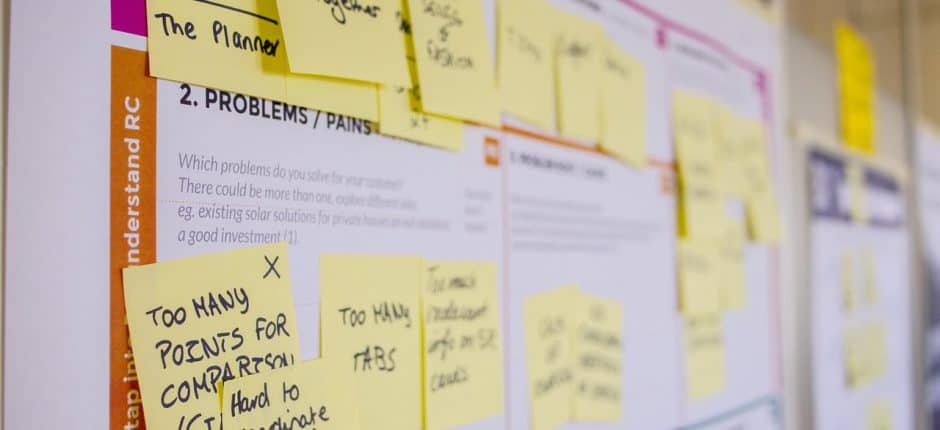A content strategy guides your marketing efforts, but if you want to do more than drive traffic, you need to be focused and tactical in your approach. Successful content can capture leads, according to Robert Rose, a founder at Content Marketing Institute. Rose says, “Companies that create and clarify a foundational documented content strategy succeed in greater numbers.”
The key is in the strategizing and development process. Rose continues, “The content creation process for businesses must be one where the content works harder, is reusable and scalable across multiple approaches.”
If you can get this right, you can make your blog work for you. In fact, 81 percent of marketers can directly tie revenue to content marketing, according to recent reports. To see ROI from your content marketing efforts, create a content strategy using the following guide as a framework.
#1: Think Beyond Blog Posts to All Content Options
Your first inclination may be to establish a blog strategy and regularly publish articles on your company’s website. While that’s a good start, your blog is only one aspect of the overall picture. To increase sales, turn your attention to other content formats.
Case Studies
Marketing company Gleam shared how their case study took only four hours to create, yet it generated up to 200 pageviews per day, while being responsible for more than $100k in revenue.
Case studies allow you to:
- Provide data-backed social proof to potential customers
- Tell a story that demonstrates success
- Build consumer/client trust
Check out the two case studies I developed to see how simple it can be:
Remember that you can also gate your case study and drive leads via a download form as well. If you’re not sure where to start with your case study, check out your competitors. See what they’re doing and let that be a starting point.
White Papers
This comprehensive piece of content acts as a research report, presenting in-depth analysis on a particular issue, challenge or methodology. White papers work well if your target audience craves educational content backed by research and data, which makes them popular in the B2B space and with high-level executives. Research reports also happen to drive the most leads with the highest conversion rates, based on a report from Ascend2.
It’s common practice to gate white papers as a way to drive qualified leads, so you’ll need to develop a landing page for this content as well.
Ebooks
Ebooks are, in essence, long-form content. Long-form content converts and performs better than it’s short-form, 500-word blog post counterpart. Dive into all the data and reasons behind this in Jeff Bullas’s in-depth guide.
The term ebook might intimidate some business owners or marketers, but don’t look at it like writing a long novel. Make your life easy and repurpose previous blog posts or other content pieces that fall within the same theme or topic. Pepper in some new information, design a cover, and set it up for downloads or sales.
Take the Course: Increase ROI With Content Repurposing
Infographics
Contently says it best: “Good infographics are like Sesame Street segments for grown-ups. They’re colorful, insightful visualizations that can break down data into a language that anyone can understand.” When your audience loves your content—like infographics—they’re more likely to interact, engage, share, and convert.
For example, Shutterstock uses proprietary data to create an annual Creative Trends infographic. The 2017 version earned mentions in more than 100 articles, 6 billion unique site visits, 5,300 social media shares, and 11,000 social engagements, according to Content Marketing Institute. That’s a lot of potential customers seeing your content.
#2: Leverage Your Blog to Drive Brand and Product Awareness
Use your blog to promote your own brand. While anyone can navigate to various landing pages on your site, don’t rely on readers to be curious. Instead, use blog ads, like pop-ups, in-text ads, post-content CTAs, or sidebar ads to get your brand in front of them. See an example from Salesforce below:

Using your blog to promote your brand gently guides potential leads to the next stage in the funnel. Remember to keep your ads relevant, based on where the reader is in your funnel, along with the theme of the content they’re reading. For example:
- A sidebar ad can be focused on a new product or service, using sales-forward language because they can choose to look past it.
- A pop-up should be educational and value-driven to encourage clicks without being intrusive—a pop-up ad can turn off readers easily, so you want to be as relevant and helpful as possible.
Like any of your marketing, always test what’s working and what’s not and optimize as you go. Check out Grow and Convert’s in-depth guide to setting up analytics and measuring the effectiveness of content-based ads.
Check out our guide on how to create digital freebies.
#3: Produce Content for Every Stage of the Funnel
A robust and thorough content strategy includes content for each stage of the sales funnel. With this built into your strategy, you can be sure every potential customer or client is getting what they need to convert. Use the following funnel stages to plan content in each area.
Research and Discovery Stage
Also known as the discovery phase, this is when a potential new lead finds your company or brand and is looking to learn something. Content for this part of the funnel includes:
- Social media posts: to generate interest.
- Landing pages: to quickly guide new leads to the right area on your website.
- Blog posts: to introduce your brand, and provide value with how-to guides, product reviews, demos, etc.
- Free downloads: to get potential clients and customers into your email funnel.
Ready to Convert Stage
Sometimes referred to as the consideration-phase, this is when your lead is hooked. They like what they see and want more information about what your brand can do for them. At this stage, you want to provide insight, including:
- Case studies: to show your brand-value and previous successes, backed by data.
- FAQs: to answer their questions before they even ask them.
- User-generated content (UGC): to provide social-proof, including reviews or testimonials from previous satisfied customers.
Find out how to unlock the value of UGC for your business, in How to Leverage User Generated Content for Your Small Business.
Post-Conversion Stage
Ensure that customers and clients return for more with content that provides value and keeps them involved. Integrate these types of content for post-conversion success:
- Surveys: to glean insights on your sales process and product/service performance and garner feedback so the customer feels heard.
- Return-customer offers: to drive more sales with exclusive deals and promotions.
- Educational product or service content: to ensure their experience with your business is easy and stress-free.
#4: Promote Content in the RIGHT Places
Once you create content, you need to promote it. For most companies, this begins with social media. Always use metrics to understand where and when you get the most clicks, who your audience is on each platform, and how you can get the most interested people to see your content.
Remember, however, that email has an even higher ROI than social media, earning $44 for each $1 spent. This makes sense, when you realize that consumers check their personal email an average of 2.5 hours on a typical weekday, according to Adobe. What’s more, half of all consumers prefer to interact and receive communications and offers from brands via email.
There are many different types of emails your business can use to connect with subscribers, promote content, and stay in touch with previous customers and clients, each of which has a different conversions rate. Check out the breakdown from Marketing Insider Group:
- Order follow up: 5% conversion rate
- Abandoned cart: 5% conversion rate
- Member follow-up: 2.7% conversion rate
- Inactive customer: 2.6% conversion rate
- Newsletter: 1% conversion rate
Include a mix of these email types into your content strategy to make the most of each opportunity.
Find more ways to promote your content in 10 Ways to Promote Your New Blog Post.
Use Your Content Strategy to Boost Sales
Don’t waste your valuable time and resources creating content without a strategy. Take the time to put an effective and sales-focused plan in place. Your content marketing will drive more sales after you establish and follow an optimized content strategy.



